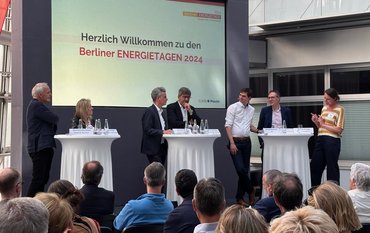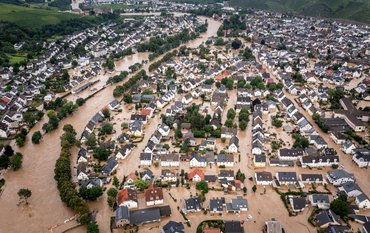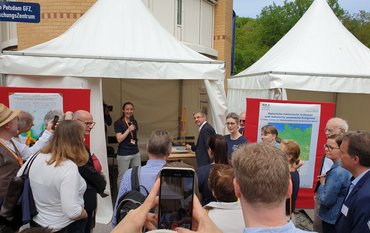The air across Europe has become markedly drier in recent decades compared to pre-industrial times. This is due to human-induced climate change. A drier atmosphere may exacerbate droughts and wildfire risk with consequences for forests and agriculture. This is the result of a new study in ‘Nature Geoscience’. It was conducted by an international research team led by Kerstin Treydte from the Swiss Federal Institute for Forest, Snow and Landscape Research (WSL). In a novel approach, vapor pressure deficit (VPD) was reconstructed as a measure for air dryness using isotopic ratios of oxygen (18O/16O) in tree-rings from a European network of forest sites.
They indicate that since the beginning of the 21st century, the air over large parts of Europe has become drier compared to any previous period – and this trend continues. “Given the drought events in many regions of Europe in recent years, this finding is really concerning”, says Kerstin Treydte.
Vapor pressure deficit (VPD) describes the “thirst of the atmosphere”, i.e. difference between the actual and the maximum possible water content of the air. “Thirsty” air with high VPD draws more water from soils and plants, reduces vegetation growth and threatens forest health. “Desiccated vegetation and soils further enhance the abundance of wildfires, as recently experienced in the German state of Brandenburg”, says Gerhard Helle from the GFZ German Research Centre for Geosciences and co-author of the study. It is known that VPD increases in a warming climate, but uncertainties are large across Europe regarding the magnitude of long-term changes back to pre-industrial times without a strong human influence. Spatially explicit data series that properly reflect regional differences across the various European climate zones are rather sparse.
Variants of atoms in water and tree rings
To resolve this issue, tree-ring data from 45 forest sites across Europe were compiled reaching back to the year 1600. The study is based on the analysis of stable oxygen isotopes, i.e. variants of oxygen with different masses (weights). “We contributed tree-ring isotope data from sites in Germany, Spain, Italy and Turkey”, says co-author Ingo Heinrich, former scientist at GFZ and now at the German Archaeological Institute, Berlin. The isotope ratios of oxygen (18O/16O) within the water (H2O) cycle are indicators of climate-related processes. Their variability is particularly related to atmospheric moisture changes as driven by air temperature and rainfall. Oxygen isotopes are assimilated by trees during water uptake by the roots. Their 18O/16O-ratios are particularly modified during transpiration of water vapor through the stomata of tree leaves, i.e. tiny little pores regulating CO2- and H2O-gas exchange between the leaves and the atmosphere. Due to the robust understanding of these underlying processes and their wide distribution trees appear to be suitable for annually resolved reconstructions of atmospheric moisture like no other natural climate archive.
Recent air drying is human-induced and strongest in Central Europe
Using model simulations, the authors performed independent tests of the results from the tree-ring isotope data. The simulations also indicate that 21st century VPD is exceptionally high compared to pre-industrial times. Even more, they demonstrate that today's VPD levels could not have been reached without greenhouse gas emissions, i.e., the human influence is obvious. Furthermore, the combination of tree-ring data, model simulations and direct measurements also elucidate regional differences: In Northern Europe, the water thirst of the air relative to pre-industrial times has increased the least compared to other European regions because the air is cooler and can take up less water. In the Central European lowlands and in the Alps and Pyrenees the VPD increase is particularly strong, with highest values in the drought years 2003, 2015 and 2018. “These findings strongly corroborate earlier results from a spatial reconstructions of European summer drought obtained from a much smaller network of tree sites (Freund et al. 2023), and highlight the interrelation of air dryness and soil moisture,” says Gerhard Helle.
Consequences for forests and agriculture
A further increase in VPD poses a long-term threat to many vital ecosystem functions. “VPD is particularly important for agriculture because the higher it is, the greater the water demand of crops. More irrigation is necessary and crop yields decrease. In forests, wood supply and carbon sequestration are at risk, leading to uncertainties regarding climate regulation and carbon storage of these ecosystems in the future”, says Treydte. This is of particular concern in the densely populated regions of Europe and adds to the urgent need of reducing emissions and adapting to climate change. “Our findings will help to refine simulations of future climate scenarios and to assess the threat posed by high VPD levels to ecosystems, the economy and society,” says Treydte, and Helle adds: “More spatially explicit data series, particularly from sites in the Polish and German lowlands are still required for a denser network so that the complex VPD dynamics are equally reflected in the different European regions”.
Original study:
Treydte, K., Liu, L., Padrón, R.S. et al. Recent human-induced atmospheric drying across Europe unprecedented in the last 400 years. Nat. Geosci. (2023).
DOI: 10.1038/s41561-023-01335-8











![[Translate to English:] Group photo with 7 people in front of a new metal plant in a large laboratory hall.](/fileadmin/_processed_/0/4/csm_20240628-GFZ_Einweihung_Triax-Anlage-PRESSE_Abb1_040_c-Bahlo-GFZ_187906cb48.jpeg)




![[Translate to English:] Heidi Kreibich, woman with short brown hair and blue eyes. She is wearing a grey cardigan and a red polo shirt](/fileadmin/_processed_/6/6/csm_kreibich-Heidi_1_Querformat_he-2021_2dedd3ef33.jpeg)




![[Translate to English:] [Translate to English:] Totes Meer gesehen von einem Hügel am Ufer](/fileadmin/_processed_/0/f/csm_20240612-web_AdobeStock_151245578_cb8e2706f3.jpeg)




![[Translate to English:] Gruppenfoto im Hörsaal](/fileadmin/_processed_/8/a/csm_240528-GfZ-ERC-Grantees-Gruppe_31be9704f5.jpeg)
![[Translate to English:] Susanne Buiter in front of a blue wall with GFZ logo](/fileadmin/_processed_/d/7/csm_20220721-GFZ-Portrait-Buiter-1-he-web_-c-Reinhardt_Sommer_2a6e3b8ae1.jpeg)
![[Translate to English:] [Translate to English:] Drohne](/fileadmin/_processed_/b/a/csm_20240515_155801_d696ee4200.jpeg)



![[Translate to English:] ein riesiges Erdloch in einer kargen Landschaft im Iran mit Bergen im Hintergrund](/fileadmin/_processed_/f/1/csm_DSC_7917_kleiner_f14e27f7ad.jpeg)

![[Translate to English:] Lecture room at GFZ with participants](/fileadmin/_processed_/a/9/csm_P1140796__002__c03fcad8bd.jpeg)

